#goa news today in marathi
Explore tagged Tumblr posts
Text
Anjali Patil Wiki, Biography, Age, Height, Weight, Family, Net Worth

Anjali Patil Wiki: Anjali Patil is an Indian actress, director, and model born on September 26, 1987, in Nashik, Maharashtra, India. She is mainly known for her role as 'Malko' in the Bollywood film "Newton." Today, we will explore Anjali Patil's biography, including her early life, family, boyfriend, movies, TV shows, and more. Anjali Patil Wiki Anjali Patil Movies Anjali Patil Web Series Anjali began acting in 2011 with the Hindi film "Delhi in a Day." In 2012, she played the role of 'Selvi' in the Sinhala film "Oba Nathuwa Oba Ekka." She also appeared as 'Durga' in the Malayalam film "Ente" in 2013. In 2015, she entered the Marathi film industry and acted in the film "The Silence" as 'Maami'.

Anjali Patil
Anjali Patil Wiki
NameAnjali PatilProfessionActress, Director & ModelNationalityIndianYears Active2011 to PresentNet Worth (approx.)₹5 CroreAnjali Patil Personal LifeNick Name AnjaliBorn (Date of Birth)26 September 1987Age (as of 2023)36 Years OldBirthplaceNashik, Maharashtra, IndiaZodiac SignLibraGenderFemaleHometownNashik, Maharashtra, IndiaHobbies/HabitsSelfie Lover, Photography, Nature LoverFavorite BrandsLevi’s, Gap, Louis Vuitton, Calvin KleinFood HabitNon-VegetarianAnjali Patil CareerDebutIn 2011 - As an ActressAwards2012: International Film Festival of India in Goa - Best Actress - (With You Without You) (Won) 2012: Stardust Awards 2013 - Breakthrough Supporting Performance - Female - (Chakravyuh) (Nominated) 2012: Star Screen Awards for Most Promising Newcomer- Female - (Chakravyuh) (Nominated) 2012: New York Indian Film Festival for Best Actress - (Delhi in a Day) (Nominated) 2012: South Asian Film Festival New York - South Asian Rising Star for Best Supporting Actress - (Delhi in a Day) (Nominated) 2013: Nandi Award - Nandi Award for Best Actress - (Naa Bangaaru Talli) (Won) 2013: National Film Award – Special Mention - (Naa Bangaaru Talli) (Won) 2016: Sarasaviya Awards in Colombo Sri Lanka - Best Actress - (With You Without You) (Won) 2016: Presidential Film Awards in Colombo Sri Lanka - Best Actress - (With You Without You) (Won)Anjali Patil EducationSchoolNot KnownCollegeLalit Kala Kendra (Pune University) National School of DramaQualificationGraduated (in Acting) Post Graduate (in Design and Direction)Anjali Patil Family, BoyfriendMotherShubha ShindeFatherSanjay ShindeSister/BrotherNot KnownMarital StatusUnmarriedAffair/BoyfriendNot KnownHusband/SpouseNot KnownDaughter/Son/ChildrenNot KnownRelativesNot KnownFriendsNot KnownAnjali Patil Body Measurements Height165 cm 1.65 m 5 ft 5 inWeight52 KG 114 lbs (pounds)Eye ColorBlackHair ColorBrownFigure Size32-30-34Dress Size36 (EU)Shoe (Feet) Size5TattoosNoneDistinctive FeaturesSmile & ConfidenceAnjali Patil Social MediaInstagramInstagramFacebookNot KnownTwitterNot KnownYouTubeNot KnownLinkedInNot KnownGmail/Email IDNot Known
Anjali Patil Movies
YearMovies2011Delhi in a Day2011Green Bangles2012Prathyayam2012Oba Nathuwa Oba Ekka2012Chakravyuh2013Ente2013Naa Bangaaru Talli2013Apna Desh2013Shree2014Kill the Rapist?2014Finding Fanny2015The Silence2015Mrs Scooter2016Mirzya2017Sameer2017Newton2018Meri Nimmo2018Kaala2019Dithee2019Mere Pyare, Prime Minister2020Mann Fakiraa2022Kuthiraivaal2022Kaun Pravin Tambe?-Bardo
Anjali Patil Web Series
YearWeb Series2019Hutatma2020Afsos2020My Client's Wife Read the full article
2 notes
·
View notes
Text
Microsoft Translator adds four new languages – Konkani, Maithili, Sindhi, and Sinhala
Microsoft India announced today the addition of three new Indian languages Konkani, Maithili, and Sindhi, in Microsoft Translator. Along with this, Microsoft Translator will also support Sinhala, the official language of Sri Lanka. With this latest release, Microsoft is further democratizing access to information in native languages for India. Microsoft Translator now supports 16 Indian languages: including Assamese, Bengali, Gujarati, Hindi, Kannada, Konkani, Maithili, Malayalam, Marathi, Nepali, Odia, Punjabi, Sindhi, Tamil, Telugu, and Urdu.
Microsoft Translator will now allow over 95% of Indians to access information and work in their native or preferred languages, making computing language-agnostic and more inclusive in India. It can help general users interpret real-time conversations, menus, street signs, websites, and documents. Companies can leverage it to globalize their business and strengthen customer outreach. Microsoft Translator can be used across Windows, iOS, Android, and the web. Microsoft also continues to push the boundaries on the quality of translations across Indian languages.
The function is available on the Microsoft Translator app, edge browser, Office 365, Bing Translator, and through the Azure Cognitive Services Translator API for businesses and developers. Users can translate Konkani, Maithili, Sindhi, and Sinhala text, supported in more than 125 languages, for their apps, websites, workflows, and tools with Azure Cognitive Services Translator. Businesses can also avail multi-language support such as translation for e-content, e-commerce product catalogues, product documentation, and internal communication, among others.
Konkani is spoken by over 2 million people in India, primarily in the states of Goa, Maharashtra, and Karnataka. It is also spoken by a significant number of people in other parts of India, such as Kerala and Gujarat. Maithili is spoken by over 75 million people in India and Nepal. It is the second most widely spoken language in the Indian state of Bihar and is also spoken in the neighbouring states of Jharkhand and West Bengal. The development of Maithili was championed by Dr. Girish Nath Jha from the Jawaharlal Nehru University (JNU) New Delhi, who provided critical test sets and initial training data. Sindhi is spoken by over 20 million people in India, and several other countries in the subcontinent while Sinhala is spoken by over 16 million people in Sri Lanka, as well as in other countries such as Malaysia and Singapore.
Rajiv Kumar, managing director, of Microsoft India, said, At Microsoft, we are committed to empowering every individual and organization on the planet and this commitment is reflected in our attempt to broaden the reach of technology and inclusiveness through language as a medium. We are excited to announce that we are broadening our language capabilities to include Maithili, Konkani, Sindhi, and Sinhala. We celebrate and support India’s diversity of language and culture with the most advanced AI to enable India’s growth, by making access to technology pervasive.
0 notes
Link
14.57 लाख लोकसंख्येच्या गोव्या राज्यामध्ये दररोज सुमारे 50 ते 75 नवीन कोविड प्रकरणे नोंदली जात होती, ज्याचा कोविड पॉझिट्व्हचा दर 5 टक्के होता. जो आज आचनक 50 टक्के झाला आहे. गोव्याचा रिकवरी दर 97 टक्के होता आणि कोविड रूग्णांची संख्या अंदाजे 700 होती. COVID-19 Goa How did the positive rate of 5 percent corona patients go up to 50 percen
#goa news#goa news in marathi#goa news live today#goa marathi news#marathi news goa#goa news today in marathi
0 notes
Link
Read latest and breaking news online in Marathi at Dainik Gomantak. Breaking News from Goa in Marathi. The largest publishing house in Goa (India).
#Dainik gomantak#dainik gomantak news#goa news#goa news in marathi#goa news marathi#goa news live#goa news today#marathi goa news#goa marathi news#marathi news goa
0 notes
Text
Unusual Destinations-1
In recent few years, I had a good opportunity to travel a lot on work. I am not an outright extrovert; I do love observing people but a part of me doesn’t allow me to kick start conversation with strangers easily. I watch people and picturize a portrait of them in my mind merely by watching them and their behavior. I have been enjoying doing this and you might call me judgmental for doing that, well maybe I am. However, I am only referring to the strangers here.
I am limited to a handful of people in my personal life and I don’t trust people easily to allow them to walk into my life. This is partly out of my insecurity of being taken advantage of. And the flip side to having limited people in life is that you expect a lot from these few people close to you. And you are always highly protective about them and constantly insecure about losing them. The world seems to end when you learn that they have made new friends and to avoid that sort of pain, I tend not to befriend many people. So, you see it’s a vicious cycle of confusion on my mind. Practically thinking I might rather have more friends and be prepared to lose one or two from time to time while the conscious part of me wants to keep my social circle as small as possible.
Anyway, too much about me, the reason I thought of begin this writing is to describe about the numerous places I have visited to. Well most of these places are not the ones you would find on the top travel destination list. But I would like to share few things which I found interesting about these places and worthy of sharing. Wherever I visit, I do a bit of personal research on things like history of the place, about the local culture and of course about the food. I am a foodie, if that’s a legitimate word.
I somehow want to start with the town of Belgaum in Karnataka, my instinct has been strongly forcing me to begin with this place.
1. BELGAUM: (Belagavi)

A good two hours drive from Hubli through a highway sided with vast stretch of lush fields and scattered human habitation takes you the town of Belgaum. The region has been center of geo political drama between the states of Karnataka and Maharashtra for decades now. The region has a sizeable Marathi speaking population and therefore should have been a part of Maharashtra state as per one faction. However in 1956, with the passage of States Reorganization Act, the district of Belgaum was incorporated in to Karanataka (Mysore State back then). Ever since both the states and the local populace have been polarized about the affiliation.
The sign of which stands firm as soon as you are about to enter the town. A massive construction called Suvarna Vidhana Soudha ( Golden Jubilee Assembly House) built by Karnataka Government as a reiteration of its control over Belgaum dots the landscape significantly. However this cosmetic gesture doesn’t mean much since the building lies unused most of the time.
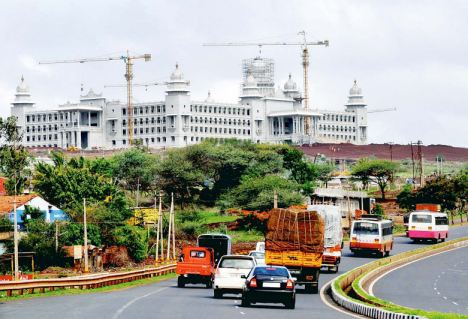
The main bazaar area of the town is a typical picture of what you would read in a Rudyard Kipling novel dated almost a century back. The hundreds of narrow alleys cris crossing the bazaar with shops giving out sharp aroma of spices and hawkers seated on ground with their neatly arranged stuffs for sale is a visual treat for someone who romanticizes the idea of vibrance. You see beautiful Marwari women with deep cut blouses and sarees tuck way below navel exposing their upper backs and tummies in just right proportion riding mopeds and honking incessantly demanding their space in congested alleys. The farmers from surrounding villages who have sold their products to the whole sellers can be spotted near wine shops and sweet shops waiting to buy their quota of celebration after weeks of efforts. The young Muslim lads who love to adore their eyes with dark mascara can be seen roaming around trading anything from cell phone sim cards to plastic toys and socks. And of course, you can’t miss seeing the hundreds of small and big shrines finding their space in between the shops and houses. Each alley has a different name and it can be very confusing as to where one ends, and another begins. “Galli” as they call it locally mostly derive their names from the deity of the shrine that guards the respective area.
Behind the lines of shops are the age-old houses which probably have been there for centuries in very same fashion and clutter as we see them today. Classification amid chaos is clearly visible, as we see ghettos segregated based on caste and religious lines. The Muslims mainly small traders or auto rickshaw drivers love to commemorate their glorious past of martialism, by furling green flags with image of their hero, Tipu Sultan on top of their houses, shops and auto rickshaw stands. On the other side, you can spot saffron flags with face of brave warrior Shivaji imprinted on them waving high over Maratha households. The Kannada speakers mainly belonging to the Lingayat community probably don’t have a flag yet, but you can find a picture of their founding father, Basavanna hanging on the walls inside their shops and houses.
It is the linguistic difference that left this place vulnerable to political scuffle for years and therefore the localities found their middle ground by adopting Hindi as a common medium of communication on streets. It is very common to find people switching from Kannada to Marathi to Hindi in flow of their conversation. Kannadigas feel it’s a natural right to speak Kannada as a primary language as they are a part of Karnataka while vast majority of Marathis are a bit reluctant to converse in Kannada. A local version of Hindi is therefore used as a neutral means of communication. The Muslims who anyway speak Deccanean Urdu (an adulterated variant of modern Hindi) obviously seem to be the happiest lot when it comes to language controversy.
Despite strong linguistic differences, the staple diet remains same for both Kannada and Marathi speakers. You will find umpteen number of houses doubling as mess, serving chapatis made of either maize flour, wheat flour or millet combined with sabzis made of pulses along with sambhar-rice. As humble it may sound, the food from these Khanavalis can be highly soothing to your soul if you have a palate for Indian home cooked meals.
The signature dish for the town is a sweet preparation called “Kunda” made from milk and caramel by curdling the former into a thick paste with several hours of boiling. I personally feel the dish is a bit over rated but since it has earned its reputation, I wouldn’t undermine it and leave it to the individuals’ taste buds to rate this local delight.
Although not by the coast itself, Belgaum is just three hours drive from Goa and therefore is well supplied with some tasty fishes from the Arabian Sea. However seafood not being the essential part of traditional local cuisine, you need to go exploring a bit to find shacks serving good fish preparations. And if you find one, don’t miss to order the “Rawas” or Indian Salmon.
The proximity to Konkan- Malvan region gifts this town with yet another boon. My personal favourite and I call it a pink nectar, if you haven’t guessed it already; I’m referring to “Sol Kadhi”. This pink colored thick beverage has coconut milk as its base, the tangy Kokkum (Mangosteen) flavor synergizes with strong garlic essence to pacify your throat and stimulate your adrenaline more sensously than any packaged energy drink.

There is no significant place to hang out or visit in town. There are few renowned educational institutes and an Army school both of which attracts students from distant parts of the country. All in all, Belgaum is not very different from the hundreds of smaller towns scattered across India, however like every bit of India it has a distinct charm of its own.
1 note
·
View note
Text
Ganapati - Once and Future Leader
In which Harsha Prabhu follows in the footsteps of the Elephant-headed God and bumps into some inconvenient truths
"Vakratunda Mahakaaya, Suryakoti Samaprabha Nirvighnam Kuru Mey Deva, Sarva Kaaryeshu Sarvada"
Ganesh Mantra
(The lord with the curved trunk and a mighty body, with the luster of a million suns I pray to thee, to remove all obstacles from my path)
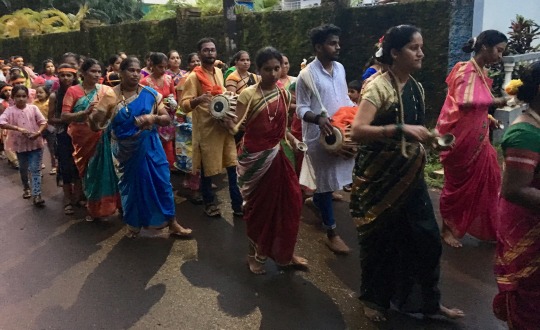
Ganapati procession, Arambol, Goa, September 2019. Pic: Harsha Prabhu
Arambol, Goa September 2019
Bhajan Mandali
Ganapati, aka Ganesh, the elephant-headed god, has many devotees among the Hindu community in India. Many Hindu households install an image of the god and offer prayers, conduct rituals and invite their neighbours for a darshan (viewing) of the god and share lunch or at least prasad (ritual offerings) together.
In the evenings, groups of musicians (mandali) go from house to house and sing bhajans (devotional songs) in his honour.
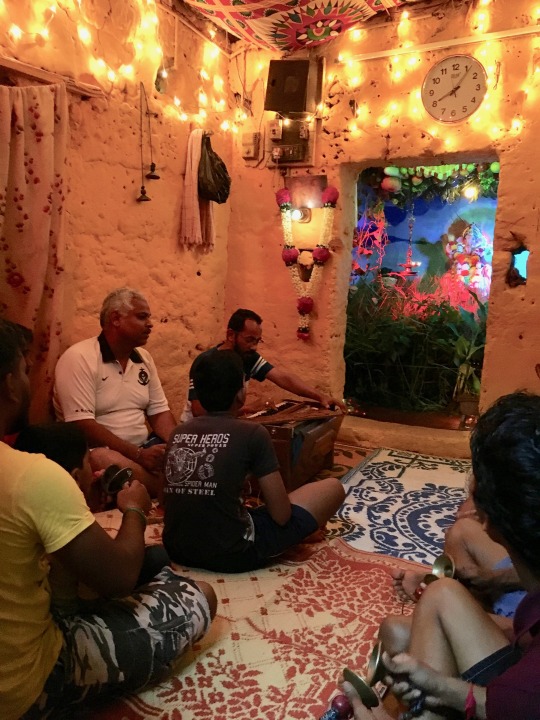
Bhajan mandali at a house in Arambol. Pic: Harsha Prabhu
One night in Arambol, I visited five households with a bhajan mandali. Apart from hymns to Ganapati there were many abhangas (songs) composed by Tukaram, the Marathi Bhakti poet-saint, beloved of the people.
The singing sessions were robust; the tea, coffee, fruit and snacks provided by every household plentiful. In one house we went to, the owner locked the doors to ensure that we finished all the food and drink he had to offer. What with the round of lunches and snacks, my midriff began to resemble the ample girth of Ganapati.
After a set number of days - anywhere between two and twenty one - these Ganapati idols are immersed (visarjan) in the sea or any available waterbody.
Sarvajanik Ganapati
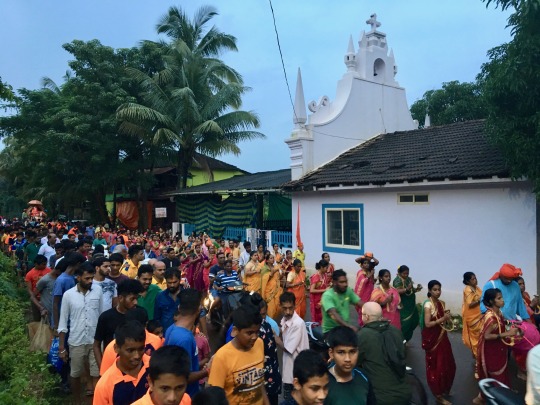
Ganapati procession, Arambol. Pic: Harsha Prabhu
Besides these household Ganapatis, there’s also the Sarvajanik Ganpati, a ‘people’s Ganapati,’ that is set up in a public place for the community to worship.
Last Thursday this Sarvajanik Ganapati - which was on show at a public hall in the village - was set atop a pick up truck and wound his way through the main street of Arambol to the sea shore. He was accompanied by singing and dancing women - resplendent in their traditional, nine-yard sarees, nose rings and other accoutrements - and children and men playing drums. Along the way groups of young boys lit firecrackers.
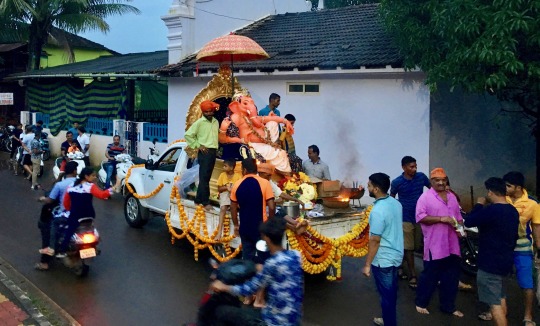
Ganapati procession, Arambol. Pic: Harsha Prabhu
To escape breathing the fumes from the firecrackers and the loud explosions they made, I made my way down to the beach. The sun was about to set; the tide was coming in.

Ganapati procession, Arambol. Pic: Harsha Prabhu
Soon groups of women descended on the beach. These were the singers and dancers from the street parade. I began to notice what sounded like a low murmur enveloping the beach. At first I couldn’t work out where the sound was coming from. Then I realised it was coming from the gathered women. They must have all been whispering prayers under their breath. It sounded like the humming of bees.

Ganapati procession, Arambol. Pic: Harsha Prabhu
Then the truck with the Ganapati appeared and manoeuvred on the sand. More prayers, more dancing by the women and drumming by the men. Fireworks lit the now-dark sky.
A simple prayer was read out in Marathi, expressing the humble hopes of the people: As in past years we have been worshiping you. Please forgive us for any misdemeanors on our part. Please help children gain knowledge through education. Please also help all people get jobs and become healthy and wealthy. Please bless everybody.
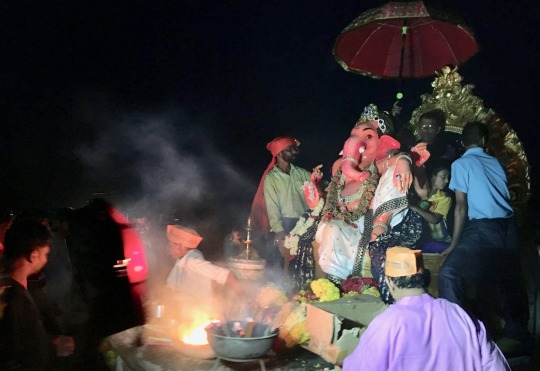
Ganapati visarjan, Arambol. Pic: Harsha Prabhu
Then, with shouts of “ Ganpati Bappa Morya, pudhcha varshi loukar ya” (Hail Father Ganapati, come back soon next year), a bunch of men lifted the idol from the truck and walked him into the sea. The incoming tide pushed the watching worshipers to higher ground. Thus ended this year’s Ganapati celebrations in Arambol.

Ganapati visarjan, Arambol. Pic: Harsha Prabhu
Leaving the beach, I heard one young man tell his friend: “Ganapati has gone. Now we can eat fish.”
This was a reference to the fact that, for the period of Ganapati’s stay in the village, Goa’s Hindus refrain from eating fish or meat of any sort, or even eggs - a big sacrifice for people for whom fish is a dietary staple.
I thought to myself: Goa’s fish better watch out.

Ganapati visarjan, Arambol. Pic: Harsha Prabhu
Ganapati - a potted history
I am indebted to the work of Debiprasad Chattopadhyaya, Marxist philosopher and historian, for much of what follows. Errors in interpretation are my own.
In his landmark book, Lokayata: A Study in Ancient Indian Materialism, Chattopadhyaya uncovers the tangled web of the Ganapati story, following its twists and turns, marking the vicissitudes of the rise and fall and subsequent rise of Ganapati.
Ganapati means leader/father (pati) of the tribe or group (gana) in Sanskrit.
Clearly, Ganapati is very old, a totemic figure from India’s tribal past.
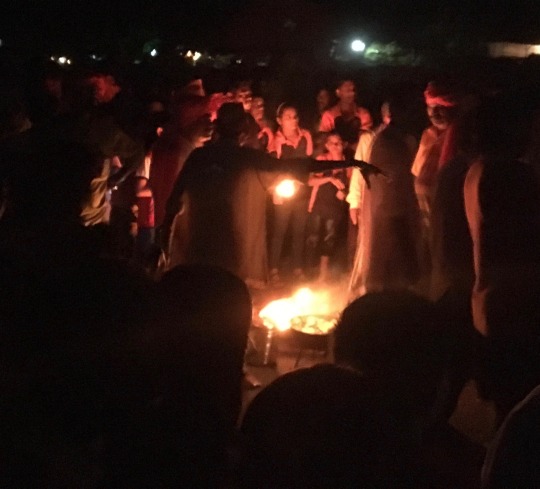
Ganapati visarjan, Arambol. Pic: Harsha Prabhu
Ganapati is mentioned in the Rig Veda (1200 - 900 BCE) as "the seer among the seers, abounding beyond measure in food, presiding among the elders and being the lord of invocation.”
In the Rig Veda, however, Ganapati refers to a person and there are many Ganapatis, described as leaders of different groups or tribes. “Ganesvaras, or Ganapatis, and Vinayakas are here represented as…many in number and present everywhere” (Bhandarkar). What’s more, the Rig Vedic Ganapati has not yet received his iconic elephant head.
Sakti Ganapati
Chattopadhyaya suggests that Ganapati is associated with the early agricultural tribal society that predates the time of the Vedas. He connects it with fertility rituals to do with mother goddess worshiping cultures.
Chattopadhyaya mentions how In some parts of India, Ganapati-worship is followed by the worship of Gauri, the mother goddess, and is connected with rituals to do with the new moon and the sowing cycle, where the goddess is depicted as “a bundle of plants, along with her human representative - a virgin.”
(I saw a remnant of this in Goa. Just before my neighbour’s household Ganapati was whisked away by the men to be immersed in the sea, the matriarch of the house ran out of the house with a sheaf of plants and blessed the idol, saying “Gauri, Gauri.”)
According to Chattopadhyaya, Ganapati is also a key figure in Tantric rituals. There are 50 different names for Ganapati in Tantric literature; and some of the followers of Ganapati (e.g. Ucchista Ganapati) were also ‘vamacaris’, ‘tantrics,’ who practiced ritual group sex.
There are also female versions of Ganapati, know as Vinayaki, shown with the head of an elephant and the body of a youthful woman (Silparatna, 16th century). These too may have Tantric origins. Similarly, the Buddhist Hevajra Tantra mentions an elephant-headed goddess, Ganaptihrdya.
Then there are the Sakti Ganapatis, where Ganapati is shown embracing a female, where the male god is depicted as being subordinate to the goddess. Chattopadhyaya points to the idol in the famous Ellora caves, where Ganesa is “subservient to the seven women, called the seven mothers (sapta matrikas).”

Ganapati procession, Arambol. Pic: Harsha Prabhu
Ganapati as trouble-maker
The patriarchal backlash was predictable.
Perhaps because of this heterodox, tribal, matriarchal and Tantric connection, in the Griha Sutras (500 BCE), commentaries on the Vedas, we find Ganapati inspires dread: a follower of Ganapati “…sees in dreams waters, men with shaved heads, camels, pigs, asses…”
The Upanishadic Brahmin sage Yajnavalkya (8th-7th century BCE) saw Ganapati in the same vein: “Being possessed of Ganapati, the Princes Royal do not obtain the kingdom.”
Chattopadhyaya’s masterly analysis - combining comparative history and anthropology - shows the Ganapati story to run parallel to the destruction of tribal society in India and the rise of monarchies and centralised state power, buttressed by the panegyrics of patriarchal Brahminism as an ideological force providing the social glue to cement the status quo, including caste discrimination.
No doubt that’s why the Manusmriti, the Lawbook of Manu (2nd century BCE - 3rd century CE), a Brahmanical text, looks down upon Ganapati. Says Chattopadhyaya: ’A couplet ascribed to him (Manu) describes Ganapati as the deity of the depressed classes, the Sudra, and this in clear contrast to Sambhu, the deity of the Brahmanas, and Madhava, the deity of the Ksatriyas.’
Indeed, many of the names of Ganapati - Vignakrit, Vignaraja, Vigneshwara - suggest this adverse history. ‘Vigna’ means ‘trouble’ in Sanskrit.
Trouble-maker Transformed
How did the Vignakrit, ‘trouble-maker’, become today’s remover of trouble?
The transformation of a radical force into its opposite is a tribute to the powers of co-option exercised by the ruling classes in all societies, but is a special hallmark of Indian culture. It’s always the winners in the culture wars that shape the narrative, that write the history books.
One way of doing this is to make room for this radical figure of popular appeal - originally a person, then a totem, now a god - and include him in the premier pantheon of the gods. Again, Indians are masters of this kind of mystification and cultural assimilation.
Thus, a whole back-story is created for Ganapati, including how he got his elephant’s head, and a new lineage, wherein he becomes the child of Shiv and Parvati, and is admitted into the mainstream Hindu canon of worship.
It’s a classic tale of the absent father, Shiva, who does not recognise his son, Ganapati, who is guarding his mother, Parvati, while she bathes. The father beheads his son; but then relents on discovering his true identity and crowns him with the head of an elephant. It’s your typical Oedipal story, but with a happy ending, worthy of Bollywood.
Far from seeing him as a trouble-maker, the medieval Puranas - especially Skanda Purana, Narada Purana and the Brahma Vaivarta Purana - are full of hyms praising Ganapati.
Chattopadhyaya, quoting A K Coomaraswamy, tells us the elephant-headed version of Ganapati that we are familiar with appears around the time of the Guptas, in 5th century CE. Before this, Ganapati is shown with other heads, including bull and snake heads, again betraying his tribal, totemic origins.
Inconvenient Truth
Still, some inconvenient truths remain to be explained.
One of the names of Ganapati is Ekadanta, ‘one-tusked’, and he is depicted thus in art and iconography. How did Ganapati come to lose one tusk?
The Brahma Vaivarta Purana says he lost his tusk in a battle with Parshurama, the Brahmin who was also a warrior. If nothing else, this suggests a struggle between Ganapati, the leader of the common people, and the aggressive Brahmin proselytisers.
Interestingly, this same Parshurama is credited with the creation of Goa. In the Sahyadri Khand of Skandha Purana, he is said to have shot an arrow at the sea god and caused the whole Konkan coast - of which Goa is a part - to be created. Here we have a thinly disguised tale of the Brahmin colonisation of South India, presented as a creation myth.
Tilak’s Dream & Hindutva
Ganapati worship in its current, public form was the brainchild of Bal Gangadhar Tilak, social reformer and nationalist, and dates from the 1890s.
Tilak observed the popularity of Ganapati among the masses in Bombay and sought to propagate it in a public manner - the Sarvajanik Ganapati - as a strategy to both subvert the British ban on people gathering in public spaces post the Indian Mutiny and as a tactic to ‘bridge "the gap between Brahmins and non-Brahmins", thereby building a grassroots unity across them to oppose British colonial rule’ (wiki).
130 years down the track - and 72 years since India won independence from the British - while the public celebration and worship of Ganapati has grown in leaps and bounds across many states in India, so has the gap between ‘Brahmins and non-Brahmins,’ which has now become a chasm, with caste-based atrocities, including lynchings of Dalits - the Sudras of the Manusmriti - on the rise in India.
Dalits are beaten up for merely growing a moustache, or riding a horse to a wedding, or participating in a dance - all activities only permitted to the upper castes. Dalits also frequently die from asphyxiation while manually cleaning sewers - which caste-obsessed India still permits in the 21st century, as a job reserved for Dalits alone.
Tilak’s dream of unity among Hindus has been zealously taken up by the Hindu Right under the leadership of the RSS and its political face, the BJP government of Narendra Modi, with the avowed aim of turning India into a Hindu nation.
Here, unlike in Tilak’s time, the enemy is not the British, but secular India.
Apart from discriminating against India’s many minority communities and tribal population, this Hindutva project is a false unity, as it’s a unity under the hegemony of the Brahmins and the upper castes, as any persecuted Dalit would know. Despite the co-option of a Dalit as the President of India.
And while Dalits continue to be an underclass, tribal India, from which matrix Ganapati originated, doesn’t even figure in the national discourse, except as a shadowy victim on the margins of a rapacious state bent on depriving tribals of their forests and livelihoods via resource exploitation and displacement caused by big dams and mining.
Echoes of the Tribal Past
D D Kosambi, Marxist historian and polymath, says: “The entire course of Indian history shows tribal elements fused into a general society. This phenomenon, which lies at the very foundation of the most striking Indian social feature, namely caste, is also the great basic fact of ancient Indian history.”
What accounts for the persistence of an ancient totemic figure like Ganapati in 21st century India?
Chattopadhyaya offers a classic Marxist analysis and points to the ‘uneven development’ of Indian society. “This feature of uneven development remains a characteristic of Indian history throughout the successive ages, down to the very modern times.”
In other words, slums coexist with smart cities, as anyone who knows India will testify.
And what is true of the social and economic life, is also reflected in people’s ideology, including religion and rituals. Superstition coexists with space travel.
Indeed, the ancient and the modern jostle for space in the Indian mind today.
While tribes decay into castes and then morph into classes in a modern context, somewhere in their hearts and minds India’s people retain echoes of the archaic, tribal past.
Meanwhile Ganapati - the father of the tribe who became a totem and then a god - still awaits his destiny as the once and future leader of the common people - and the remover of all obstacles in their path.
#ganapati#arambol#goa#totem#marxists#history#philosophy#photography#tribal#indian history#sakti#tantra
8 notes
·
View notes
Text
Majura's son to represent India, 14-year-old Vishwanath selected in sailing team! | News - News18 Lokmat, Today's Latest Marathi News
Majura’s son to represent India, 14-year-old Vishwanath selected in sailing team! | News – News18 Lokmat, Today’s Latest Marathi News
A 14-year-old boy has been selected in India’s Sailing Team (Optimist World Sailing Championship 2021). Padidala Vishwanath, the son of a laborer, is the youngest sailor from Navy Boys Sports Company, INS Mandvi, Goa. Mumbai, July 7: A 14-year-old boy has been selected in India’s Sailing Team (Optimist World Sailing Championship 2021). Padidala Vishwanath, the son of a laborer, is the youngest…

View On WordPress
0 notes
Text
Trending Entertainment News Today - Jaan Kumar Sanu's mother REACTS to MNS threat over anti-Marathi remark; Karan Johar's crew dumps PPE kits in Goa after shoot
Trending Entertainment News Today – Jaan Kumar Sanu’s mother REACTS to MNS threat over anti-Marathi remark; Karan Johar’s crew dumps PPE kits in Goa after shoot


It is Wednesday and a lot of bizarre things have been happening in the world of entertainment. From Maharashtra Navnirman Sena (MNS) threatening to stop the shoot of Bigg Boss 14 over Jaan Kumar Sanu allegedly insulting the Marathi language to Karan Johar landing in trouble for the alleged indiscriminate dumping of PPEs and other unsegregated garbage by the production crew, these entertainment…
View On WordPress
0 notes
Link
The BJP government left Corona patients in the air to die; Rahul Mhambare
#marathi news paper goa#goa online newspaper#marathi news goa#goa latest marathi news#goa news today in marathi#the goa newspaper online
0 notes
Text
Over 3000 students appear for Goa Board's HSSC exam - Times of India
New Post has been published on https://apzweb.com/over-3000-students-appear-for-goa-boards-hssc-exam-times-of-india/
Over 3000 students appear for Goa Board's HSSC exam - Times of India

PANAJI: Over 3,000 students on Wednesday appeared for the Goa Board’s Class 12 Marathi examination which was earlier postponed after the COVID-19 outbreak.
Social distancing norms were followed while conducting the examination, the board’s chairman Ramakrishna Samant said.
The students were asked to use hand sanitiser before entering the examination halls and wearing masks was compulsory for them, he said.
“Total 3,823 students were eligible for appearing in the Higher Secondary School Certificate (HSSC) examination today,” Samant said.
The examination was held hassle-free and almost all the students appeared for it, he said.
As per some pictures released by the state government, students maintained social distancing and wore masks in the examination halls.
The HSSC Marathi exam was earlier supposed to be held on March 20, but was postponed in the wake of the COVID-19 crisis.
Since the state was declared a green zone on May 1 after all the seven COVID-19 patients previously found recovered, Chief Minister Pramod Sawant earlier this month said the HSSC and SSC examinations would be held after the third phase of the lockdown ends on May 17.
The state board accordingly announced that HSSC examinations will be held from May 20 to May 22 (for two pending papers), while the SSC (Class 10) exams for all papers will be held from May 21 onwards.
However, since the last week, coronavirus cases were again detected in the state.
As of now, there are 41 active COVID-19 cases in the coastal state.
Source link
#Coronavirus#COVID-19 outbreak#higher secondary school certificate#hssc marathi exam#marathi examination#ramakrishna samant#social distancing norms#SSC examinations#Career
0 notes
Text
updates 1/2 - Goa
Our Diwali break started Friday. Our weekly Friday excursion was put aside and we had a party in the afternoon instead. I wore my sari which was finished just in time for the party; it’s a pale blue-grey with gold stripes. I’ll post a picture (I keep saying that. I’ll actually do that today). We introduced all of our host parents to the other students, and our parents introduced us to the other parents. It seemed like everyone was matched with their family really well and everyone is settled now. I feel a little more settled, anyway. I still get homesick, especially lately, but the semester is officially half over. A lot has happened since my last post so I’m not sure where to start, chronologically. I guess I’ll just type and see where it takes me.
The last weekend of September, most of us students took a holiday in Goa since we had that Monday off. We had to book a random, inexpensive hotel last minute because we waited too long to book the original one we were looking at and it was taken by someone else. After a very long, twelve-hour bus ride, we arrived in Goa near Baga beach Saturday morning. We were able to check in early to the rooms we booked: two rooms for the 11 of us. The rooms each came with a pretty large bed, but the people renting out the room gave us extra mattresses to lay on the floor. My room had five people, with me and the other two girls on the bed and two of our three boys on the floor mattresses. Sharing the room, bathroom, and deciding what to do with the air conditioning (everyone but one person wanted it off; too cold) took some adjusting but it didn’t become too big of a problem since we were there only two nights. Saturday we went to the beach, which the room owner said was a mere five minute walk from where we stayed. It was at least 15 minutes, maybe more depending on the heavy traffic that squeezed through the small, very muddy streets near the beach. The water was salty and a perfect temperature. The sand was fine and not too hot to stand on barefoot. We had been told that the farther south you go in India, the less people stare or take photos without permission. I thought maybe Goa was south enough of Maharashtra that we could escape the unwanted attention like we had received at Ajanta-Ellora. Not south enough, it turned out. Later, a friend told me that south Goa beaches, the ones meant for tourists and rich people, are safer and kinder to travelers. Oh well, next time.
Saturday night in Goa was fun though. I went to my first nightclub (ever) after we had dinner at a restaurant which served cheap, strong drinks. I might’ve gotten more than tipsy that night. The first club we went to was very small but being a group of Americans comes with perks, I guess. They first gave us a free round of shots, then a *whole* free bottle of sprite and vodka. I was more interested in dancing, for the record, if my family happens to read this.We stayed there a while and then moved on to the famous club in the area, Tito’s. I broke my shoe while dancing there and the lady checking bags confiscated an apple that I had bought earlier in the night for breakfast the next day. A stray dog laid at the base of the steps going up to the dance floor and I thought it must be so loud for it to lay there, but when we came down to leave later it was gone. The bag-checking lady still had my apple when I left and I took it, proud of intoxicated-me for looking out for morning-after me by providing a healthy breakfast. In the morning, I woke up early and with an unhappy stomach. The first bite of my apple hit a rotten spot, but I thought nothing of it and decided to eat around the spot. A few bites later I realized the apple was inhabited by worms. Many worms. I walked down the road to find a different breakfast.
The rest of the weekend was somewhat uneventful, but welcome after all the work we were doing for our classes. We had lunch at another well-known place and a few of us walked around shops for a while before heading to the beach one last time. The day before I had worn my one-piece swimsuit with shorts over it but that didn’t stop a group of guys around our age from harassing us. They circled around us in the water when we didn’t even look their way and splashed us in the face. The saltwater hurt my eyes but I’m glad they didn’t try anything else. Sunday, I skipped the swimsuit altogether and wore a new tourist-y Goa t-shirt with loose, black pants and just stood in the water up to my knees. Nearby, two of the other girls from our group were repeatedly telling another group of men that they don’t want their picture taken when one of them threw sand at their faces. We left soon after that. A few of us were expertly pressured into buying some anklets from women selling mostly to foreigners. They said things like, “Your skin is so fair and pretty! Not like us, we look like monkeys.” We were all made uncomfortable by this and I wasn’t sure if they believed it as a result of the colorism that came during the colonial times or if it was just a clever compliment to boost sales. I can’t say for sure but I think about it often.
The next morning, we left with our hired bus driver to begin the long drive home. Home, because that’s what Pune is feeling like now. Especially after going out of state where we could not communicate with the little Marathi we had learned. In only three or four days I had started to miss the pace of the city and the routine I had settled into. And I missed my ai’s cooking, and watching Marathi serials with them at dinner. I can’t wait to get home, real home, and see my real mother and my dogs and all my friends at school. But I can tell that leaving Pune will also be very difficult. I have friends here now, and a temporary family. I look for familiar stray dogs when visiting different parts of the city. I know where to find the most reliable rickshaws, and I know how to tell them when they’ve charged me too much. People look surprised when I show understanding when listening to a conversation, and when I even contribute to it. I feel like part of me has rooted here, fed by the daily rains that should have stopped with monsoon season. Before I know it, it’ll be time to dig them up again to board a flight back to the US.
1 note
·
View note
Text
Krishna on the Beach
Harsha Prabhu wanders on a beach in Goa and stumbles upon the God of Love
Arambol, Goa, August 2019
The Photoshoot
It was the weekend of the global protest against the destruction and burning of the forests in the Amazon basin, aided and abetted by the Brazilian government.
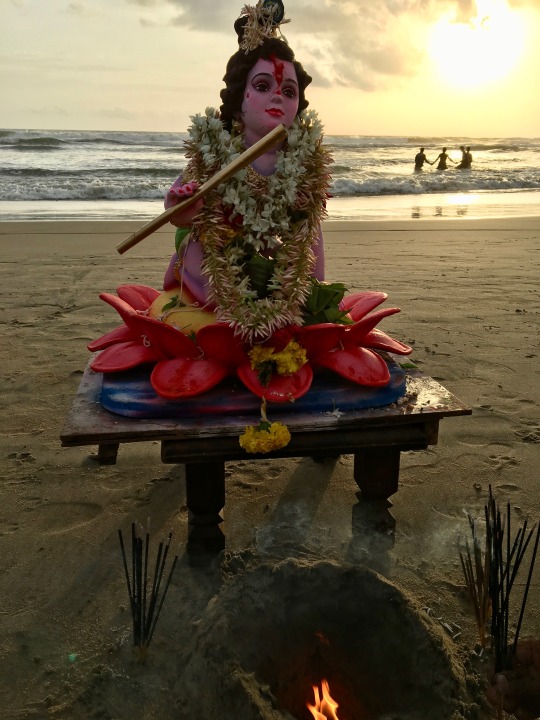
A few of us decided to hold a pop up demonstration at Arambol beach against this act of environmental vandalism that threatened the livelihood of the indigenous people of Brazil - and 20% of the world’s oxygen supply. The demo would be in the form of a photo shoot, with people holding placards that spelt: SOS Amazon! We needed a quorum of 12 people to hold the placards. Seemed easy enough.
But it wasn’t. It took us a full hour of hustling on the beach to get the magic 12. Many we asked begged off for one reason or another: they did not understand what I said (Russian tourists); they were waiting for someone; they had to be somewhere else; they had to discuss it with their group before agreeing to participate. Some of these procrastinators were clearly entitled, middle class Indian tourists from major metros, visiting Goa as part of a package tour, sporting t-shirts with the tour logo. Somehow, we managed to find 12 souls willing and able to be a part of the the visual petition against the Amazon destruction.

After the photoshoot I wandered along the beach. Then I heard the sound of bells. Turning, I saw a group of men striding down the beach. One of them was carrying something on his head; the others were playing zills and chanting “Radhe Krishna ki jai!” (Hail Radha and Krishna).
The man who was carrying an idol of Krishna - Bal Krishna, Krishna as a child - placed it on the beach. His companions dug holes in the sand and placed incense sticks, to light which they borrowed my lighter. Slowly, people gathered around the idol; bits of camphor were burnt as offerings; prayers offered.
There was a large group of young boys who were playing in the sand nearby. Ever the opportunist for a photo grab, I went up to them and, addressing the biggest boy, asked: “Have you heard of the burning of the forests in the Amazon in Brazil?” “Yes” , he replied “ I saw it on the news.” “Would you like to help us stop it?” I asked him. “How?” he asked. “Simple. Just join with your friends in holding these placards,” I replied, “ I’ll take a photo and send it to the Brazilian government.”
“Yes, yes,” he shouted and turned to explain to the rest of his friends what was proposed. Before I could say ‘Krishna’ I had 12 eager and willing young participants in the photoshoot. In an attempt to get them all in the frame I almost stumbled onto the Bal Krishna image on the sand.
Krishna Lila
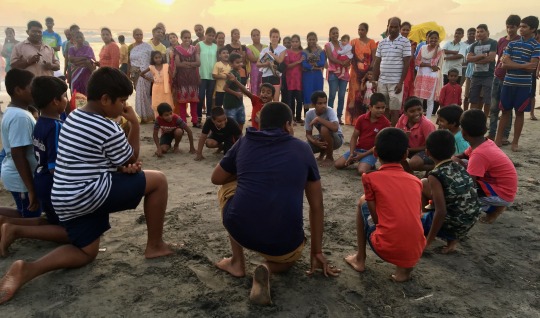
It was only then that I realised the young boys where part of a group that had come to participate in the Krishna ritual on the beach. In my mind’s eye, I saw them as the gopas (cow-herders) of Vrindavan, Krishna’s accomplices in his childish pranks, which, to the devotee, is an expression of the God’s ‘Lila,’, life as play.

And play they did, that evening on the beach, first the young boys, then the older youth and some men joining in. Games of tag, of skill and strength and guile. Then they attempted to smash the ‘Dahi Hundi’, the pot of yogurt - an object of mischievous fascination for Bal Krishna, called ‘Maakhan chor’, the butter-thief - held tantalizingly out of reach by a man wielding a rope and pully. Both groups of young boys and older youth managed to smash the Hundi, splattering themselves and those nearby with yogurt.
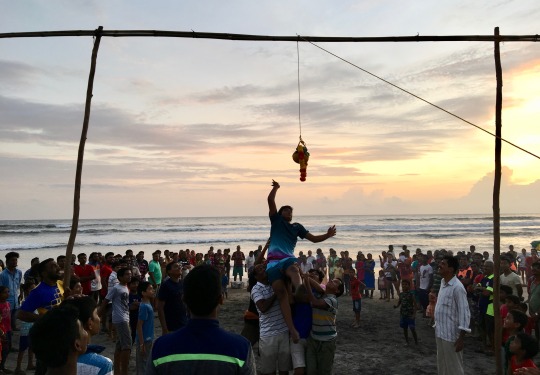
Where were the gopis (milk-maids) in all this play? Some stood by watching, like the ladies from Rajasthan, looking, with their aquiline features, nose rings and veils, like they had stepped out of a Kishangarh miniature, the 18th-century school of painting from Rājasthan, celebrating Krishna as a lover. Other gopis, possibly tourists from interstate or overseas, cavorted in the sea, holding hands in the water, playing their water games, framed by the setting sun.

Then it was time for more prayers and - as the sun set and the horizon turned maroon - time for the ‘Visarjan,’ the ritual immersion of the Krishna idols - the Bal Krishna being joined by a Krishna playing the flute - in the sea.
Who is Krishna?

Yesterday was Gokulashtami , the birthday of Krishna. Today is Visarjan. Who is Krishna, this God who was born yesterday and is committed to the waters the very next day?
Who is Krishna? This question bedevilled Arjun, the hero of the Mahabharata war, contemplating the field of battle. Is he my charioteer? My devoted friend and wise councillor? Or is he a God whose true face I dare not see?
There are many Krishnas; you can pick and choose.
There’s the culture hero of the Ahir, a tribe of pastoralists found in north and western India. The Ahirs are mentioned in the Mahabharata and some Ahir claim descent from the Yadava clan of Krishna.
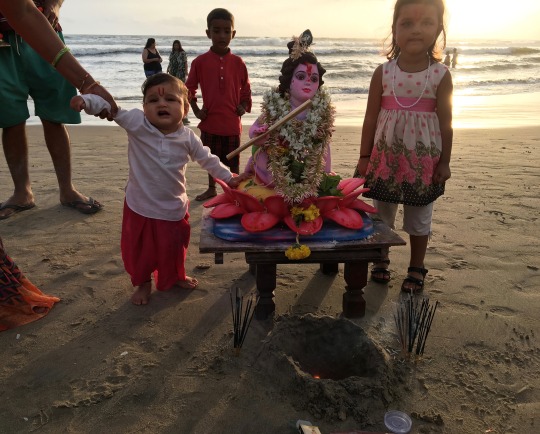
There’s Bal Krishna, the baby Krishna, whose exploits form the material of songs mother’s sing to their children, whose devotion parallels the cult of baby Jesus.
There’s Krishna the lover, flirting shamelessly with the gopis of Vrindavan, all the while knowing his heart is with Radha, another man’s wife, in an erotic wheel-within-wheel of transgression, celebrated in much Indian song, dance and art.
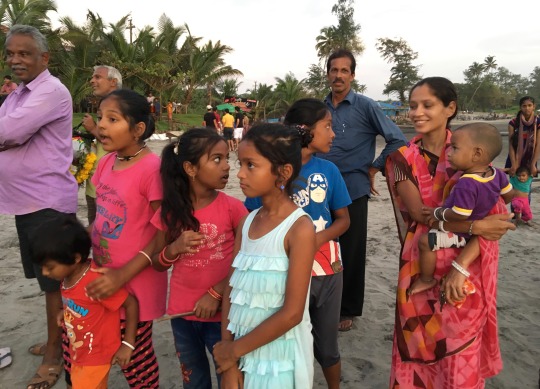
There’s the Krishna of the Bhagvad Gita, Arjun’s initiator into the terrifying mysteries of cosmic time, including the need to do one’s caste-defined, destiny-propelled duty, regardless of the consequences (nishkamakarma).
This was the Krishna that troubled M K Gandhi, possibly the greatest Vaishnav (Krishna devotee) of them all in recent times. The arguments in the Geeta rationalising violence, no doubt the work of Brahmins versed in the arts of sophistry in defence of the status quo, stuck in Gandhi’s throat. Gandhi would have agreed with D D Kosambi, polymath and Marxist historian, who said: ‘This slippery opportunism characterizes the whole book. Naturally, it is not surprising to find so many Gita lovers imbued therewith. Once it is admitted that material reality is gross illusion, the rest follows quite simply; the world of "doublethink" is the only one that matters.’
Bhakti
There’s the Krishna of the Bhakti saints, the social movement that was anti-caste, that talked up love for one’s fellow human as the highest goal.
The Bhakti saints came from all castes. Nammalvar was a peasant. Namdev was a tailor. Gora was a potter. Cokha Mela was Dalit. So was Ravidas, guru of Mirabai and contemporary of Guru Nanak. Jyaneshwar, who introduced the Gita to Marathi-speakers, committed ritual suicide. Tukaram, the greatest Marathi Bhakti poet of them all, was a peasant, who ran afoul of Brahmins, and is supposed to have drowned himself in the river Tungabhadra. There’s more than a hint that he was murdered by caste Hindus. Luckily, his abhangas (poems) survived…

What made Bhakti so radical?
Here is Chandidas, the 15th century Bengali poet:
"Shobar upor manush shotto tahar upore nai,” (“Above all is humanity, none else”).
Or Kabir, possibly the greatest of India’s many poet-saints, also from the 15th century, and a Muslim to boot, though not a practicing one by the looks of it. He wrote in the vernacular and, even to this day, his poems explode in the face, like existential firecrackers.
Saints I see the world is mad.
If I tell the truth they rush to beat me,
if I lie they trust me. — Kabir, Shabad 4, Translated by Linda Hess and Shukdeo Singh
Or this:
Saints I've seen both ways.
Hindus and Muslims don't want discipline, they want tasty food.
The Hindu keeps the eleventh-day fast, eating chestnuts and milk.
He curbs his grain but not his brain, and breaks his fast with meat.
The Turk [Muslim] prays daily, fasts once a year, and crows "God!, God!" like a cock.
What heaven is reserved for people who kill chickens in the dark?…
— Kabir, Śabda 10, Translated by Linda Hess and Shukdeo Singh
Or this one:
If God be within the mosque, then to whom does this world belong?
If Ram be within the image which you find upon your pilgrimage,
then who is there to know what happens without?…
— Kabir, III.2, Translated by Rabindranath Tagore and Evelyn Underhill
Interestingly, Kabir ran afoul of both Muslims and Hindus during his lifetime. It is said that, upon his death, both sets of believers fought over his corpse. When they lifted his shroud, all they found were flowers.
Knowing the pain of others
Here is Narsi Mehta, the 15th century Gujarat poet-saint, with a song that was a favourite of M K Gandhi:
Vaishnav jan to tene kahiye je/ Peed paraayi jaane re /Par-dukhkhe upkaar kare toye /Man abhimaan na aane re
Only he is a true Vaishnav Who knows the pain of others Does good to others without letting pride enter his mind.
Indian PM Modi also claims to love ‘Vaishnava jan to.’ He launched a version of the song in October 2018, sung by artists from 40 different countries, as the start of the year-long celebration of the 150th birth anniversary of Gandhi.
Does Modi know the pain of others?
This was his reply to a Reuters journalist in 2013, when asked what he felt about the communal carnage in Gujarat that lead to over a thousand deaths, mainly, but not only, Muslims, and the displacement of many more while he was CM in 2002: “If someone else is driving a car and we’re sitting behind, even then if a puppy comes under the wheel, will it be painful or not? Of course it is.”
Does Modi know the pain his policies, including demonetisation and high GST rates, have caused his people? The pain of all those who have lost their jobs due to an economy in shambles, largely due to the wreaking-ball of his government’s own policies? Does he know the pain of the farmers who commit suicide due to failing crops, drought and the inability to pay back loans? Or the pain of all the human rights defenders and tribals who languish in jail on trumped up charges? And what about the pain of the Kashmiri people?
What about the pain of Gandhians? The fact is that M K Gandhi himself was assassinated by a Hindu ring wing terrorist, a member of the Hindu Mahasabha, an off-shoot of the RSS, the very organisation that Modi belongs to.
What about the pain of all those people - mostly Muslim, Dalit or Christians - who have been lynched in India by mobs yelling “Jai Shree Ram”?
In July this year, eminent writers, filmmakers and intellectuals wrote an open letter to PM Modi, beseeching him to act, saying: "It is shocking that so much violence should be perpetrated in the name of religion! These are not the Middle Ages! The name of Ram is sacred to many in the majority community of India. As the highest Executive of this country, you must put a stop to the name of Ram being defiled in this manner.”
Modi has yet to respond to the letter.
Clearly, when it comes to knowing the pain of others, Modi has a lot of catching up to do.

Krishna the Redeemer
The Krishna story should make all tyrants everywhere worried.
For Krishna is also the redeemer. He comes to deliver the people of Dwarka from the rule of the evil tyrant Kamsa. Indeed, all tyrants dream of everlasting rule, but Kamsa himself hears a voice that tells him his end is near. This sets into play the whole Krishna myth, of the child abandoned by the palace, like Moses was among the bullrushes, a foundling fostered by another family, who grows up to avenge wrongs and claim his rightful throne.

According to Joseph Campbell: ‘The work of the incarnation is to refute by his presence the pretentious of the tyrant ogre.’
Further, Krishna, as the God of Love, refuses to allow himself to be weaponised by the armies of the Hindu Right, as opposed to the fate of poor Ram, where “Jai Shree Ram” has become a rallying cry of the lynch mobs.
Ironically, the actual form of greeting in parts of North India is “Jai Sia-Ram”; ‘Sia’ being a short form for ‘Sita’. But there’s no use for Sita, the Goddess of the Earth and Ram’s wife, in the hyper masculine world of Hindutva politics. The Goddess - and women - are the first casualties in Hindutva’s Raas Lila (sacred dance, dedicated to Radha-Krishna), where rape is a political tool to terrorise and subjugate people, sanctioned by V D Savarkar, the father of Hindutva ideology.
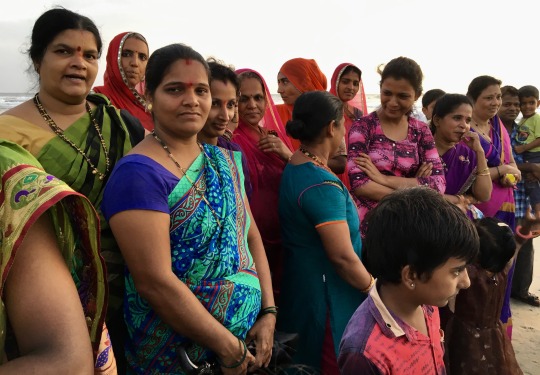
For Krishna devotees, Krishna is nothing without Radha; therefore it’s always “Jai Radhe-Krishna.” Behind Krishna stands the Mother Goddess. Vrindavan, the scene of the Krishna idyll, is the sacred grove (vana) of the Goddess Vrinda, another name for the Tulasi (holy basil) tree. To this day, the marriage of Krishna to Tulasi is celebrated every year in Vrindavan as Tulasi Vivaha. And even in Goa, for my landlord, Pritesh, was married to three Tulasi trees before he got a wife. Thus does the Great Mother break through Hinduism’s patriarchal bonds.
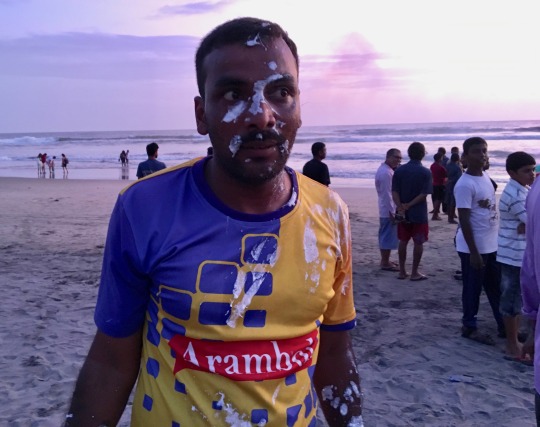
And it’s not just Hindus who worship Krishna.
According to literary critic Kuldeep Kumar, writing in The Hindu: ‘Many Muslim poets, the most notable among them being Raskhan, wrote devotional poetry to celebrate the Krishna legend and to rejoice in his bhakti. Abdur Rahim Khan-e-Khana, who is known in Hindi literature simply as Rahim, wrote many Barwais, Dohas and Sorthas in praise of Krishna. For example, this couplet is worth reading.
Jihi Rahim man aapno keenho chandra chakor Nisi baasar laago rahai Krishna chandra kee or (The way chakor always looks at the moon, similarly my face is always towards Krishna’s face that is as beautiful as the moon is). ‘ Chakor is a kind of partridge.

Passion Play
The passion play I witnessed on the beach was part of an ancient story, of the birth and sacrifice of a God. Like the Greek hero, Achilles, Krishna dies when an arrow pierces his heel, betraying his tribal, pagan origins. The culture hero dies, but the energies of an archetype never die, but live on, forever green in the hearts of men and women.

Surely Krishna - the hero with a hundred faces - will come to the aide of his people, wherever they may be, on a beach, in a temple, in the factories, on the land, in the forest, the vana, his favourite playground - or at the next political or environmental protest.
In a time of human-induced climate chaos and species extinction, driven by corporate fascism’s dystopian republic of greed, ruled by the global police state, the Radha- Krishna myth - of the world as a garden of plenty, as a playground for the divine erotic impulse to manifest, of love as the highest form of worship - is a very compelling counter-image.
Another world is possible. Krishna tells us it is.
While lovers of radical equality and seekers of bliss rejoice, tyrants everywhere better beware. Even as we speak, Krishna is on his way to Dwarka…
Pics: Harsha Prabhu
A note on the photoshoot:

Amazon photoshoot, Arambol, Sat 24 Aug 2019
SOS AMAZON! SOS CLIMATE EMERGENCY! Arambol, Goa, India Sat 24 August 2019
Members of Extinction Rebellion Goa staged a pop up demonstration at Arambol beach in solidarity with the native people of Brazil’s Amazon basin, whose forests are being burnt by the Brazilian government to facilitate development projects, including roads and big dams, in an ecologically sensitive bio region.
The burning forests of the Amazon are also a matter of grave concern as they supply 20% of the world’s oxygen. These forests are characterised as the lungs of the planet, taking in carbon dioxide and breathing out oxygen.
In addition, this wanton destruction feeds into the cycle of human-induced climate change. With the accelerated melting of the Greenland ice field via global warming predicted to raise sea levels by a frightening 25 feet, coastal communities like Goa are at special risk of being inundated by such irresponsible actions.
Activists also pointed out that India’s environmental record too was a scandal, with the continued destruction of forests, especially in the Western Ghats, leading to flooding in several states, including Goa, Maharashtra, Karnataka and Kerala. In Mumbai, the Aarey Forest in the centre of the city, also earmarked for development, and coastal mangrove destruction, are causing environmental stress on one of the world’s mega cities, also subject to periodic flooding.
India ranks among the bottom five countries on the Environmental Performance Index for 2018, according to a biennial report by Yale and Columbia Universities and the World Economic Forum. India also has the dubious distinction of overtaking China and Russia as the world’s top sulpha dioxide polluter, according to a Greenpeace report released on 19 August 2019. Sulpha dioxide is a by-product of coal-based electricity generation. Fossil fuels are also the key culprits in the global warming feedback loop and the proliferation of plastic pollution world-wide, including on Goa’s beaches.
With extreme weather events - like drought followed by floods in India - the norm, activists worldwide are calling upon governments to address the climate emergency, stop the reliance on fossil fuels and rapidly move towards adopting sustainable solutions to meet world energy needs.
The Brazil solidarity action - which included Arambol youth and local and international visitors - was part of a global weekend of similar demonstrations to put pressure on world governments to act now before it’s too late!
Pic: Harsha Prabhu, Design:Camelia Oberoi
#SOSAmazonia #SaveOurForests #ClimateEmergency #extinctionrebellion #extinctionrebellionindia #extinctionrebelliongoa #arambol #goa #DeclareClimateEmergency #SaveAareyForest #SaveWesternGhats
#sosamazon#krishna#radharani#lila#gokulashtami#gopi#gopa#bhakti#photography#goa#arambol#climate emergency#species extinction#extinctionrebellion
6 notes
·
View notes
Text
Astrology App Android Phone
Contents
Key astrological insights easy
App store rating: 4.5
Simultaneously collects high-spectral-resolution data
Download – sharechat
Latest technology based app developers
Daily horoscope predictions
Android is the world’s most popular mobile operating system, but it’s also the most vulnerable. Here’s how to check if your Android phone has been hacked.
Astrology Chart Template Cafe Astrology The Houses Astrology 2019 Bejan daruwalla astrology zone blood moon The term black moon refers to an additional new moon that appears in a month or in a season.It may also refer to the absence of a full moon or of a new moon in a month. The moon drives your deepest feelings,

It can be so helpful to have Astrological insights at your fingertips! These 5 Astrology apps make accessing key astrological insights easy and convenient. … icon-mobile app store rating: 4.5 stars … 3 MOON APPS FOR iPHONE & ANDROID.
Fourier-transform infrared spectroscopy (FTIR) is a technique used to obtain an infrared spectrum of absorption or emission of a solid, liquid or gas. An FTIR spectrometer simultaneously collects high-spectral-resolution data over a wide spectral range. This confers a significant advantage over a dispersive spectrometer, which measures intensity over a narrow range of wavelengths at a time.
Astrology Zone Pisces November This month, dear Pisces, you are likely to find December more dreamlike than … tenth house of honors, awards, and achievement last month on November 8. I love that Neptune will be making the closest, tightest, positive aspect to that new moon november 7. Neptune is your ruler and is traveling in Pisces. Neptune … Leo
Google Groups allows you to create and participate in online forums and email-based groups with a rich experience for community conversations.
Gaze into your crystal ball with the 7 best horoscope and astrology apps … This app is also compatible with Android devices, as well as the iPhone and iPad.
ShareChat App download – sharechat is all in one app to get everything related to fun on your Smartphone.The application lets you get everything related to fun and the general knowledge daily from India within a second.
Astrology Chart Making To create your free birth chart (natal chart) enter your name, place of birth (or nearest city), and date of birth below. Entering your birth time is optional, but … Natal astrology, also known as genethliacal astrology, is the system of astrology based on the concept that each individual’s personality or path in life can be
Get now the Best horoscope apps for Android, including Horoscope and … "IDK with the other users but I can actually download this app for my android phone.
Mobile Apps – Download Free Astrology Apps by AstroSage. Get free smartphone apps for astrology by AstroSage. We are leading Virtual Reality Games, Android, iOS, Windows, artificial intelligence, machine learning and more latest technology based app developers for astrology, horoscope, kundli, rashifal and much more.
Astrology Today Marathi Marathi (English: / m ə ˈ r ɑː t i /; मराठी Marāṭhī; Marathi: [məˈɾaʈʰi] ()) is an Indo-Aryan language spoken predominantly by around 83 million Marathi people of Maharashtra, India.It is the official language and co-official language in the Maharashtra and Goa states of Western India, respectively, and is one of the 22 scheduled
Dec 21, 2017 … Do you start your day with the daily horoscope predictions? Do you believe that the stars shape your fortune? Do you seek astrologers for …
0 notes
Text
Certified Translation Marathi To English

A country cannot be associated with a single culture, especially if it is as big as India. Although everyone believes Indian culture to be vibrant and colorful, people don’t pay much attention to different ethnicities living in the country. A population of 1.3 billion is divided into 28 states and eight union territories. People of different ethnic and religious backgrounds live in India. But you can observe the culture and linguistic overlap between some states. Some provinces have the same majority tongue. The country itself recognizes multiple languages officially to protect and promote their usage. However, English is used during the parliamentary proceedings. It is also used as the medium of communication by the administrations of the center and states.
The Marathi Language:
One of the most spoken tongues in India is Marathi. In the state of Maharashtra, it is the only vernacular recognized by the constitution. It also enjoys official status in Goa along with Konkani. Some of the best-preserved literature in the world is in Marathi. Due to its literature dating back to 600 AD, it is considered one of the oldest living Indian languages. It has more than eighty million speakers, which makes it a very important vernacular in today’s world. The alphabet of the tongue has 52 letters, out of which 16 are vowels. The vowels and consonants are divided into different groups. The two scripts used to write Marathi are Devanagari and Modi. The tongue has two popular dialects, Standard Marathi, which is used by the majority and the government of the state, and the Varhadi dialect. Since both Hindi and Marathi are written in the Devanagari script, their written forms have a lot of similarities. A native speaker of Hindi will be able to understand Marathi with a little effort. Due to the popularity of the Devanagari script, the usage of the Modi script is declining. Governments and media are trying to bring back the latter.
Maharashtra:
India’s second most populous state is the biggest contributor to the country’s economy. One important factor that attracts foreign investors is the industrialization in Maharashtra. This is why it has the largest economy in all the provinces of India. Not only is it a culturally and historically rich place but also highly suitable for businesses, both big and small. There are multiple UNESCO World Heritage Sites in this province. The medieval sites have been one of the biggest attractions for tourists in Maharashtra. The culture of Maharashtra is known for its delicious cuisines, engaging literature, entertaining movies, and performing arts. Various sports are played in the state, some of which are indigenous.
Certified Translation Marathi To English:
Maharashtra is home to numerous IT companies. However, no progress will be of much value if it is not shared with the world. Companies working in the region need to get Marathi to English translation from time to time to connect their native workers with the outside world. The translation also helps them in sharing their success story with foreign investors. It is the best way to show the potential of this state to the outside world. A significant number of IT experts, web developers, and entrepreneurs live in the state of Maharashtra. There are a lot of opportunities for them in their province. But they might also have to travel to represent their country at international conferences. Some experts also have to immigrate to a foreign country when their company gives them a promotion. However, preparing for such a move is not easy. Leaving your homeland and settling down in a new country means going through a complex process. But if you don’t take on the opportunity, you will be ruining your chances of success. In today’s world, finding good jobs and being able to move to a developed country is not something that everyone can do. People have to try really hard to achieve their goals. So, when you are presented with an opportunity, you shouldn’t give up on it because it involves a lot of complications. You can’t achieve anything without making some effort. When you are applying for immigration, you will have to get all your documents in order. When you apply to a country where the official language is English, you will need to get your birth certificate translated.Since a birth certificate is an official document, you can only submit its certified translation. That is the only type of translation which is accepted by embassies and immigration offices. However, the birth certificate translation from Marathi to English can only be carried out by an expert who is a native speaker of the former tongue. Non-native speakers don’t know a language well enough to work as its translator. And if you don’t know where to find a native translator, there is no need to panic. All you have to do is do some research on the internet and find a good agency that offers Marathi to English translations. If they have native speakers on their team, you can trust them to provide you with quality services. In order to get the certificate translation India, make sure the expert you hire knows about the dialects spoken in Maharashtra and will be able to translate your document properly. The right agency will be able to offer you a translation that will get accepted by immigration offices. They will know what kind of certification you need with the linguistic service depending on your requirements, and they will assist you accordingly. Read the full article
0 notes
Quote
Best Festivals in Odisha Ganesh Chaturthi (गणेश चतुर्थी) Festivities of Ganesh Chaturthi across India and outside One of the significant celebrations of our custom and culture is Ganesh Chaturthi which is watched generally by Hindu individuals. As a rule, individuals carry a symbol of Lord Ganesha to their home and love for 10 days, and on the eleventh days the amazing visarjan happens. This visarjan or inundation of Lord Ganesha in some water body is a melodic and brilliant parade. At the point when the celebration is sorted out by some nearby gathering or club, they like to get monster size symbols of Lord Ganesha and proceed with music, move, and other social shows or occasions for 11 long days. This constant festival is an exuberant one and individuals truly admire investing some pleasant energy with their friends and family. Essentially in India, Ganesh Chaturthi is praised at an enormous scope in conditions of Madhya Pradesh, Maharashtra, Gujarat, Goa, Karnataka, Kerala, Andhra Pradesh, Telangana, and Tamil Nadu. As the zones are unique, there is a slight change in the method of venerating or festivity of this celebration. In the event that we look carefully into the method of festivity, we discover two unmistakable contrast in the way Ganesh Chaturthi is commended at home and out in the open. In Maharashtra, it appears as though every family is commending their sort of Ganesh Chaturthi. Every single state is related to a type of celebration and Maharashtra is well known for its Ganeshotsav. Ganesh Chaturthi at Home In the homes of Maharashtra, the families introduce little and vivid earth sculptures of Lord Ganesha to be revered during the celebration. Blossoms and durva or the youthful grass, karanji, and modaks are offered during the morning and night adoring meetings. In Maharashtra, the Marathi aarti formed by the seventeenth-century holy person Samarth Ramdas "Sukhakarta Dukhaharta" is sung to pay tribute to Lord Ganesha. The families choose when to end the festival and that clearly fluctuates. In the event that Ganesha is venerated at home, the celebration may end after 1 and a half, 3, 5, 7, or 11 days relying upon the desire of the host. In Maharashtra, one would likewise observe Hartalika that is seen with a quick by the ladies of the families on the day before Ganesh Chaturthi. Gauri celebration likewise happens here with the establishment of symbols of Gauri which is the other name of Devi Durga. In Konkani culture of Goa, this Ganesh Chaturthi is known as Chavath or Parab or Parva. Ruler Shiva and Goddess Parvati is venerated by the fasting womenfolk of the family. Ghumots, Pakhavaj or two-headed drums, and crash cymbals are played all through the customs. The extremely following day is saved for Navyachi Pancham when new paddy from new gather is brought from the fields to proceed with the love. During this celebration individuals turn carefully veggie lovers. Gowri celebration goes before Ganesh Chaturthi in Karnataka while in Andhra Pradesh, Matti Vinayakudu ie. Dirt sculptures of Lord Ganesha and Siddhi Vinayakudu ie. Turmeric sculpture of Lord Ganesha are venerated at home with Plaster of Paris icons. Ganesh Chaturthi in broad daylight: Neighborhood gatherings of youth, relationships of individuals or clubs, or a gathering of specialists or tradespeople arrange Ganesh celebration in an enormous manner. Assets are gathered from open or gifts are given by rich individuals. The icons or sculptures of Lord Ganesha are then brought into mandaps or pandals and an arrangement social projects are followed. Let loose clinical check, blood gift camp, appropriation of food, sweet, and attire to poor people and destitute additionally structure a piece of the celebration whenever composed by clubs or gatherings. Much the same as the enormous demonstration of Dusshera in West Bengal, this Ganesh Chaturthi celebration is something more than the strict criticalness. There is a monetary point to it too. In Mumbai, Pune, Surat, Hyderabad, Chennai, and Bengaluru, numerous specialists, industrialists, and representatives locate a productive method of salary for this celebration. In Tamil Nadu, this celebration is known as Vinayaka Chaturthi or Pillayar Chaturthi. It falls on the fourth day after the new moon in the long stretch of Avaṇi in the Tamil schedule. One would discover icons made up of mud or papier-mache as mortar of Paris is prohibited in this state. Interestingly, symbols of Lord Ganesha here are likewise comprised of coconuts and other natural things. In the wake of revering or a few days, the icons are drenched in the Bay of Bengal. In Kerala the name of this celebration is Lamboodhara Piranalu and it falls in the period of Chingam. Last yet not the least, in Thiruvananthapuram, you would discover a procession walks from the Pazhavangadi Ganapathi Temple to Shankumugham Beach, with tall sculptures of Lord Ganesha which is made out of natural things as it were. Another fascinating certainty is that milk is submerged in the ocean. Aside from our own India, you would likewise discover the festival of Ganesh Chaturthi anyplace over the existence where Hindu culture is relaxing. The UK is a significant spot of Indian migrants and the Hindu Culture and Heritage Society of Southall praises this celebration in Vishwa Hindu Temple. It began to structure the year 2005 and the icon is inundated in the Thames at Putney Pier. In North America, Canada, Malaysia, Mauritius, and Singapore, one can see an enormous festival for Ganesh Chaturthi. On the promising event of Ganesh Chaturthi, otherwise called 'Vinayak Chaturthi' individuals across Odisha are praising the celebration with intensity and jollity. The 10-day celebration that denotes the start of the happy season in Odisha commends the introduction of Lord Ganesha, the more youthful child of Lord Shiva and Goddess Parvati. Colossal symbols of Lord Ganesh worshiped a few brightened pandals at different places over the state, including Bhubaneswar, Puri, Cuttack, Khordha, and Rourkela. Schools, universities, and youth clubs sorted out uncommon Puja to check the celebration. Individuals offered supplications to Lord Ganesh who is known as the God of beginnings for riches, sciences, information, knowledge, and thriving. Ganesh Chaturthi - Odisha In the capital city, individuals were seen crowding Puja pandals set up at Rupali Square, Janpath, Madhusudan Nagar, Shastri Nagar, Unit-4, and Unit-8 to offer supplication to Lord Ganesh. Ganesh Puja otherwise called Ganesh Chaturthi is being praised with strict intensity across Odisha, today. A few finished pandals with tremendous symbols of Lord Ganesh have been set up at different places over the state, including Bhubaneswar, Puri, Cuttack, Khordha, and Rourkela. In the capital city, individuals were seen crowding Puja pandals set up at Rupali Square, Janpath, Madhusudan Nagar, Shastri Nagar, Unit-4, and Unit-8 to offer supplication to Lord Ganesh. In addition, schools, universities, and youth clubs sorted out unique Puja to check the celebration. Understudies wearing new garments were seen taking an interest in uncommon Puja in schools and universities. For More Details, please visit - https://www.odishahospitality.com / http://www.elicitodisha.com/ https:// odishahospitality.blogspot.com
http://unmaskodisha.blogspot.com/2020/05/ganesh-chaturthi-vinayaka-chaturthi.html
0 notes
Link
ध्वनी प्रदूषणामुळे पक्ष्यांची घरटे नष्ट होतात, परंतु गोव्यातील एक महिला आपल्या नैसर्गिक जगात सूक्ष्म जीवांना सुरक्षित जागा उपलब्ध करुन देण्याचा प्रयत्न करीत आहे. This lady from a fishing village rescued the bird chicks that fall down from the nests in Goa
#goa online newspaper#marathi news goa#goa latest marathi news#goa news today in marathi#the goa newspaper online#marathi newspaper in goa#goa breaking news#latest marathi news from goa#goa newspaper online#goa breaking news online
0 notes